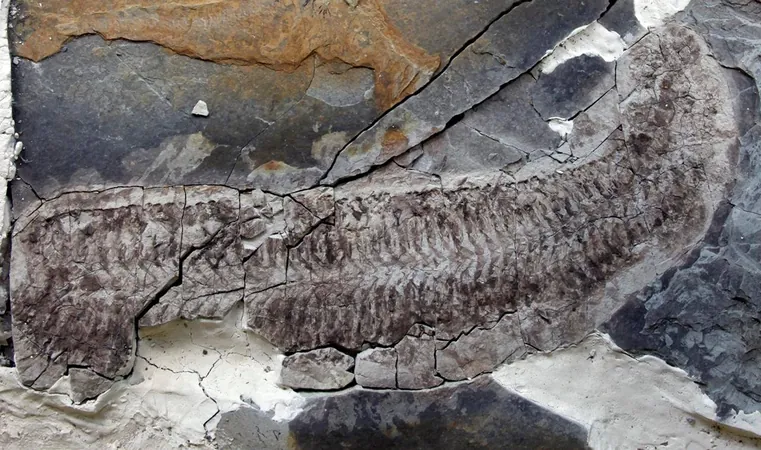
Meet Sue: The Incredible 444-Million-Year-Old Fossil That Transforms Our Understanding of Marine Life!
2025-03-27
Author: Li
A Groundbreaking Discovery
A groundbreaking discovery has emerged from the depths of South Africa that could change everything we know about prehistoric marine animals. Researchers have unveiled an astonishing fossil of a new ancient arthropod species, Keurbos susanae, which is estimated to be 444 million years old! This monumental find, called ‘Sue’ in honor of the lead researcher’s mother, Professor Sarah Gabbott of the University of Leicester, offers an unprecedented look into the internal anatomy of long-extinct marine creatures.
Unique Preservation
What sets this fossil apart from the countless others found over history? While most arthropod fossils typically preserve hard exoskeletons, Sue’s remarkable condition grants scientists a first-ever glimpse at its internal organs, including delicate muscles, tendons, and parts of the digestive system. This soft tissue preservation is exceedingly rare in the fossil record, making Sue a true marvel of paleontology.
The Soom Shale
The fossil was uncovered in the Soom Shale, a unique sedimentary formation located about 250 miles north of Cape Town. This area was once a thriving marine basin that somehow survived one of Earth’s most catastrophic events—the glaciation that contributed to one of the five mass extinctions, during which nearly 85% of all life was eradicated. Remarkably, this refuge allowed for the survival of a distinct array of ancient marine life, with Sue being one of its most extraordinary examples.
A Paradox of Preservation
Sue presents a fascinating paradox: while her soft tissues are beautifully preserved, her head and legs have been lost to the ravages of time. "Sue is an inside-out, legless, headless wonder," notes Professor Gabbott, emphasizing the incredible nature of this fossil. The reason behind the exceptional preservation of her internal structures can be attributed to specific chemical conditions in the sediment—namely an anaerobic, hydrogen sulfide-rich environment—that likely hindered the decomposition of soft tissues while allowing external features to decay.
An Ultramarathon of Research
The long journey to identify and analyze Sue has been nothing short of an odyssey for Professor Gabbott. She first discovered the fossil early in her career, but it wasn’t until 25 years later that it was thoroughly studied and described. Unfortunately, the small quarry where Sue was found has been exhausted, leaving no prospects of future finds. "This has been an ultramarathon of a research effort," Gabbott explained. “The fossil’s preservation is so intricate that every layer demanded our attention, revealing more about this ancient organism."
Challenges in Classification
With remarkable soft tissue details but missing external features, classifying Sue within the arthropod family tree remains a challenge. Still, the data gleaned from her unique state offers invaluable insights into the evolutionary history and life strategies of ancient arthropods.
The Name ‘Sue’
As for the name ‘Sue,’ it carries both personal and professional significance for Professor Gabbott. "My mother always encouraged me to pursue a career that brings joy, no matter what it is," she shared. "When I told her I was naming the fossil after her, she quipped that I should do it before she became a fossil herself! So, I jokingly tell her that I named it Sue because she, too, is a well-preserved specimen, acknowledging her endless support."
Conclusion
Sue’s discovery is not just a fascinating addition to paleontology; it opens doors to understanding an ancient world that thrived under extreme conditions. As researchers continue to delve into the mysteries of such specimens, who knows what else awaits us in the realm of ancient life? Stay tuned!


 Brasil (PT)
Brasil (PT)
 Canada (EN)
Canada (EN)
 Chile (ES)
Chile (ES)
 Česko (CS)
Česko (CS)
 대한민국 (KO)
대한민국 (KO)
 España (ES)
España (ES)
 France (FR)
France (FR)
 Hong Kong (EN)
Hong Kong (EN)
 Italia (IT)
Italia (IT)
 日本 (JA)
日本 (JA)
 Magyarország (HU)
Magyarország (HU)
 Norge (NO)
Norge (NO)
 Polska (PL)
Polska (PL)
 Schweiz (DE)
Schweiz (DE)
 Singapore (EN)
Singapore (EN)
 Sverige (SV)
Sverige (SV)
 Suomi (FI)
Suomi (FI)
 Türkiye (TR)
Türkiye (TR)
 الإمارات العربية المتحدة (AR)
الإمارات العربية المتحدة (AR)